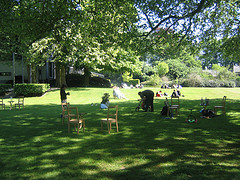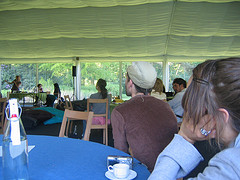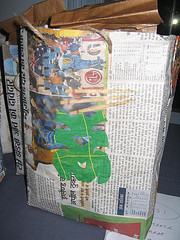 Yesterday, i attended the Luminous Green symposium, organized by the lovely FoAM people, on the Groenhoven Estate, near Brussels. The event was exactly what it promised to be: a fantastic gathering of people from different fields and who all battle for a more sustainable environment. There were artists, fashion designers, grassroot activists, business leaders, people from the governement, etc. The aim of the event is to get them to talk together. Not in a self-congratulory spirit but to collect successful stories and see if people from different background can define a common ground.
Yesterday, i attended the Luminous Green symposium, organized by the lovely FoAM people, on the Groenhoven Estate, near Brussels. The event was exactly what it promised to be: a fantastic gathering of people from different fields and who all battle for a more sustainable environment. There were artists, fashion designers, grassroot activists, business leaders, people from the governement, etc. The aim of the event is to get them to talk together. Not in a self-congratulory spirit but to collect successful stories and see if people from different background can define a common ground.
If you’re in Brussels on the 4th, i can only recommend you to head to FoAM and see how artists, designers and engineers translate the issues and suggestions that popped up during the conference into sketches and prototypes.
FoAM set up Luminous Green to reflect on the importance of creativity practice into the environmental debate. The aim is to go beyond the discussion about the effects of global warming. The debate is rather to see how we can adapt to life in turbulent and anti-environmental conditions and more precisely: How can designers, artists and other creative people contribute to the discussion? Maja Kuzmanovic, who curated the event, suggested that what designers and artists can bring into the discussion is:
 – 1. An integrated approach to complex problem solving.
– 1. An integrated approach to complex problem solving.
Problems cannot be isolated, they are part of a big picture. We have created unstable systems and they have to be attacked from different approaches and fields. Everything is interconnected and interdependent. This requires a holistic trial and error approach.
– 2. The participatory nature of creative practices.
Today, prescribing universal solutions doesn’t work. There are as many approaches as there are problems. We shouldn’t look for solutions but for ecologies of solutions
– 3. The ability to design beautiful things that people might want to surround themselves with.
Buckminster Fuller said: “When I am working on a problem I never think about beauty. I only think about how to solve the problem. But when I have finished, if the solution is not beautiful, I know it is wrong.”
 If we design or create beautiful things, people will not only want to have it but will also want to be part of the community that made it. Beauty makes it easier to draw people’s attention.
If we design or create beautiful things, people will not only want to have it but will also want to be part of the community that made it. Beauty makes it easier to draw people’s attention.
It’s time to be proactive and behave like the avant-garde that many claim to be.
The conference was as sustainable as possible which was not easy at all:
– difficult to find furniture created in a truly sustainable way (good recycling conditions, good working conditions, etc.) The only things they could find were prototypes or showroom pieces,
– they wanted to organize the event in an eco-chateau but nothing of the kind exists in Belgium,
– they got two hybrid cars from Lexus but 50 persons cannot fit in a car. Now Brussels uses hybrid buses for public transport, the only problem is that they cannot go out of Brussels. Regulations wouldn’t allow that.
However, they produced very little printed documents, offered picnic snack in lovely bags designed and hand-crafted by people from the Barefoot College and managed to convince the speakers to either use no projections or be content with the very poorly lighted ones. And it worked marvellously.
Conclusion: there’s still so much work to do, especially for people who don’t have large pockets. We need more tangible products and we need to connect them together to achieve the desired impact.
